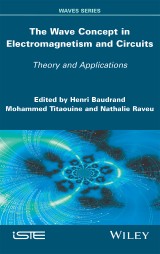Details
The Wave Concept in Electromagnetism and Circuits
Theory and Applications1. Aufl.
|
139,99 € |
|
| Verlag: | Wiley |
| Format: | EPUB |
| Veröffentl.: | 16.08.2016 |
| ISBN/EAN: | 9781119347774 |
| Sprache: | englisch |
| Anzahl Seiten: | 216 |
DRM-geschütztes eBook, Sie benötigen z.B. Adobe Digital Editions und eine Adobe ID zum Lesen.
Beschreibungen
<p>The Wave Concept Iterative Procedure (WCIP) method has found an increasing number of users within electromagnetic theory and applications to planar circuits, antennas and diffraction problems. This book introduces in detail this new formulation of integral methods, based on the use of a wave concept with two bounded operators, and applications in a variety of domains in electromagnetics. This approach presents a number of benefits over other integral methods, including overcoming the problem of singularity, and reduced computing time.</p> <p>Through the presentation of mathematical equations to characterize studied structures and explanation of the curves obtained, via validated examples, the authors provide a thorough background to electromagnetism as well as a professional reference to students and researchers.</p>
<p>Preface ix</p> <p><b>Chapter 1. General Principles of the Wave Concept Iterative Process 1</b><br /><i>Henri BAUDRAND, Med Karim AZIZI, Mohammed TITAOUINE</i></p> <p>1.1. Introduction 1</p> <p>1.2. The iterative wave method 3</p> <p>1.3. General definition of waves 5</p> <p>1.4. Application to planar circuits 5</p> <p>1.5. Applications to quasi-periodic structures 6</p> <p>1.6. Circuits with localized components 7</p> <p>1.7. General principles of quasi-periodic circuits 7</p> <p>1.8. The significance of using auxiliary sources 8</p> <p>1.8.1. Description of the environment 9</p> <p>1.9. Unidimensional circuits 9</p> <p>1.10. Application: transmission line 14</p> <p>1.11. Comparison of current density for different cell lengths 14</p> <p>1.12. Bi-dimensional circuits 16</p> <p>1.13. Two-source bi-dimensional circuits 16</p> <p>1.14. Three-source bi-dimensional circuits 22</p> <p>1.15. Validation examples 25</p> <p>1.16. Lenses and meta-materials 34</p> <p>1.17. Conclusion 41</p> <p><b>Chapter 2. Formulation and Validation of the WCIP Applied to the Analysis of Multilayer Planar Circuits 43</b><br /><i>Alexandre Jean René SERRES and Georgina Karla DE FREITAS SERRES</i></p> <p>2.1. Introduction 43</p> <p>2.2. WCIP formulation 45</p> <p>2.2.1. Multilayer formulation 45</p> <p>2.2.2. Simulation results 48</p> <p>2.3. Real and ideal polarizers within planar structures using WCIP 52</p> <p>2.3.1. Formulation 52</p> <p>2.3.2. Results 55</p> <p>2.4. Amplifier structure of compact micro-waves 57</p> <p>2.4.1. Formulation of the amplifier interface 57</p> <p>2.4.2. The simulation results 59</p> <p><b>Chapter 3. Applications of the WCIP Method to Frequency Selective Surfaces (FSS) 63</b><br /><i>Mohammed TITAOUINE and Henri BAUDRAND</i></p> <p>3.1. Introduction 64</p> <p>3.2. Formulation of the iterative WCIP method 65</p> <p>3.2.1. Determining the diffraction operator 68</p> <p>3.2.2. Determining the reflection operator 70</p> <p>3.2.3. The fast modal transform FMT and its inverse FMT−1 72</p> <p>3.2.4. FSS multilayer devices 72</p> <p>3.2.5. Multi-level plated FSSs 72</p> <p>3.3. Application of the iterative WCIP method to different FSSs 74</p> <p>3.3.1. Dielectric short-circuited FSS rings 74</p> <p>3.3.2. FSSs charged by lumped elements and active FSSs 76</p> <p>3.3.3. Multi-frequency band FSSs 79</p> <p>3.3.4. Double-layer FSS plating 80</p> <p>3.3.5. Triple-layer plating 82</p> <p>3.3.6. Thick FSSs 83</p> <p>3.4. Anisotropic FSS 95</p> <p>3.5. Measurement system 96</p> <p>3.6. Conclusion 97</p> <p>3.7. Acknowledgments 98</p> <p><b>Chapter 4. WCIP Applied to Substrate Integrated Circuits: Substrate Integrated Waveguide (SIW) and Substrate Integrated Non-Radiative Dielectic (SINRD) Circuits 99</b><br /><i>Nathalie RAVEU and Ahmad ISMAIL ALHZZOURY</i></p> <p>4.1. Introduction 99</p> <p>4.2. Formulation of WCIP for SIC circuits 100</p> <p>4.2.1. The definition of 103</p> <p>4.2.2. The definition of 103</p> <p>4.3. Results for SIW circuits 104</p> <p>4.3.1. Waveguides 104</p> <p>4.3.2. Bandpass filter 106</p> <p>4.4. Results for the SINRD circuits 108</p> <p>4.4.1. Waveguides 110</p> <p>4.4.2. Bandpass filter 111</p> <p>4.5. Conclusion 112</p> <p><b>Chapter 5. WCIP Convergence 115</b><br /><i>Nathalie RAVEU</i></p> <p>5.1. Introduction 115</p> <p>5.2. Summary of WCIP 116</p> <p>5.2.1. Representation of homogeneous materials around the interface 117</p> <p>5.2.2. Description of boundary conditions at the interface 118</p> <p>5.2.3. System to solve 118</p> <p>5.3. Improvement of WCIP by mathematical techniques 119</p> <p>5.3.1. Number of modes/number of meshes 120</p> <p>5.3.2. GMRES/Richardson 121</p> <p>5.3.3. Selecting the initial value 122</p> <p>5.4. Improvement of WCIP by physical considerations 124</p> <p>5.4.1. Simplification of waves at the interface 124</p> <p>5.4.2. Choice of reference impedance 125</p> <p>5.4.3. Boundary conditions on the metallic mesh 126</p> <p>5.5. Conclusions 127</p> <p><b>Chapter 6. Application of WCIP to Diffraction Problems 129</b><br /><i>Noemen AMMAR, Taoufik AGUILI and Henri BAUDRAND</i></p> <p>6.1. Introduction 129</p> <p>6.1.1. Diffraction by multilayer cylindrical structures 130</p> <p>6.1.2. Descriptors for spectral components of reflection operators 132</p> <p>6.1.3. The modal coefficients ext n Γ and int n Γ 133</p> <p>6.1.4. Modal coefficients pass n Γ 134</p> <p>6.1.5. Spatial diffraction operator 136</p> <p>6.1.6. Excitation source 137</p> <p>6.1.7. Iterative process 138</p> <p>6.2. Application 138</p> <p>6.2.1. Dielectric cylinder diffraction 139</p> <p>6.2.2. Diffraction by metallic strips 143</p> <p>6.2.3. Coaxial multi-strip structure 148</p> <p>6.2.4. Diffraction by two dielectric co-axials 156</p> <p>6.2.5. Diffraction by structures of any shape 159</p> <p>6.3. Coupling simulation 160</p> <p>6.3.1. Different operators involved 162</p> <p>6.3.2. The case of two pixels on a single fictitious cylinder 163</p> <p>6.3.3. The case where the two pixels are part of two coaxial cylinders 164</p> <p>6.3.4. Spatial descriptors of diffraction operators 167</p> <p>6.3.5. The iterative process 169</p> <p>6.3.6. Computation of the remote location electric field 169</p> <p>6.3.7. Application 170</p> <p>6.4. Conclusion 183</p> <p>Bibliography 185</p> <p>List of Authors 195</p> <p>Index 197</p>
<p><b>Henri Baudrand</b> is Emeritus Professor at the University of Toulouse; INPT, UPS; LAPLACE; ENSEEIHT in France.</p> <p><b>Mohammed Titaouine</b> is Associate Professor in the Faculty of Technology, University of Batna 2, Algeria.</p> <p><b>Nathalie Raveu</b> is Professor at the University of Toulouse; INPT, UPS; LAPLACE; ENSEEIHT; CNRS in France.</p>
Diese Produkte könnten Sie auch interessieren:

Strategies to the Prediction, Mitigation and Management of Product Obsolescence

von: Bjoern Bartels, Ulrich Ermel, Peter Sandborn, Michael G. Pecht

116,99 €

















